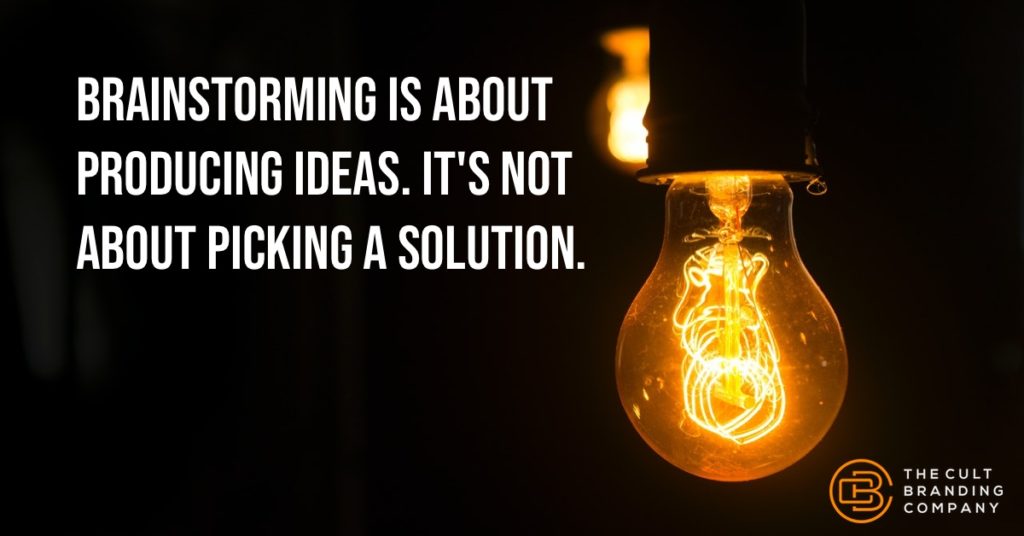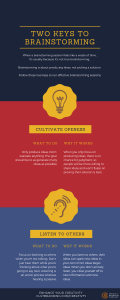
If you’re like most businesspeople, you’ve entered problem-solving meetings excited to devise a solution, but then left feeling like you wasted valuable time.
Often, the solution is similar to something already in place or it was brought up early in the meeting. It feels like the meeting could have been more easily accomplished in an email that didn’t take you away from your desk.
With results like these, it’s easy to question the value of brainstorming. And, it’s understandable why most businesses don’t devote time to regular brainstorming sessions.
What is Brainstorming Really?
Most “brainstorming” meetings look something like this: A bunch of people get in a room and suggest solutions to a problem. People comment on the ideas as they come up. Eventually, one mediocre idea triumphs.
But, this isn’t brainstorming.
Brainstorming, as conceived by advertising executive Alex Osborn, consists of coming up with as many ideas as possible (wild or tame), without passing any judgment.
Brainstorming is about producing ideas, not picking a solution.
This why most problem-solving meetings produce poor solutions: they fail to set aside time to focus solely on generating ideas.
Ideation + Evaluation = Less Ideas
By not focusing solely on idea generation, what ends up happening is that the meetings become a free-for-all with anyone being able to say what they want, whenever they want.
It may seem like this the best way to encourage people to think freely and create a steady flow of ideas. But, it does the opposite: it causes people to fixate on ideas and have their thoughts drift toward existing solutions.
As creativity researcher Patricia D. Stokes observes, “Free to do anything, most of us do what’s worked best, what succeeded the most often in the past.”1
Additionally, allowing people to say anything they want combines the processes of ideation and evaluation. Ideation activates a different part of the brain than evaluation. And, by switching back and forth between these two modes of thinking, you impede the ability of either function to work at its maximum level. In short, switching between ideation and evaluation hinders the generation of ideas.
These sessions end up resulting in a battle over a narrow range of ideas. And, that isn’t brainstorming.
Evaluating solutions should come after the brainstorm has ended, not as part of the brainstorming session.
Creating an Environment of Openness
The brainstorm leader’s goal is to make sure that communication isn’t forced in one particular direction. The leader should help keep everyone on track and set an open, nonjudgmental tone for the session.
The leader must make it clear that there will be no criticism of ideas. The goal is to get as much feedback, ideation, and data out of the group as possible—not to discuss a specific solution.
This method is contrary to the way most people approach group brainstorming. The goal is not to come into the meeting with an idea in mind and then try to win people over to your way of thinking.
Brainstorming isn’t an essay contest or a debate. Evaluating and deciding on a solution comes later. It is essential that the leader makes this distinction clear.
Focus exclusively on generating ideas without judgment. This forces people into being more open and receptive, creating optimal conditions for idea generation.
Facilitating the Art of Listening
The most important factor in producing ideas in a group brainstorm is listening to other people’s ideas, without constantly focusing your attention on the solution you want to champion.
Hearing is a passive act of sensing sound. Listening is a conscious, active process that requires you to give your full attention to the person speaking.
Creating an attitude of openness by not allowing evaluation in the brainstorm makes it easier for people to listen. It’s harder to fixate on a solution when there’s no chance that a decision will be made. The natural impulse to prove a solution becomes minimized.
The creative process is the result of linking ideas to existing memories or ideas and creating new combinations. By listening to others during a meeting, you have the opportunity to receive new ideas that can combine with your own ideas and memories to create more new ideas.
Ideas propagate ideas.
Generating as many ideas as possible is important, as there’s a direct correlation between the quantity and quality of ideas: the more ideas generated, the greater the quality.
Like Ray Dolby, creator of the Dolby NR noise reduction system, advised, “You have to have the will not to jump at the first solution, because a really elegant solution might be right around the corner.”2
Two Keys to Making Your Brainstorming Sessions Work
Establishing an environment of openness and listening to others creates the best conditions for brainstorming.
Remember:
- Create an environment of openness. Only produce ideas; don’t evaluate them.
- Actively listen. Pay attention to what others say. Ideas propagate ideas.
Focusing on openness and listening will vastly improve your ability to generate original and valuable ideas.
Everyone I’ve taught these keys to—whether in my creativity workshop or when I introduce them before leading meetings—has found them to be valuable in their own work. I hope you do too.
_______________________

